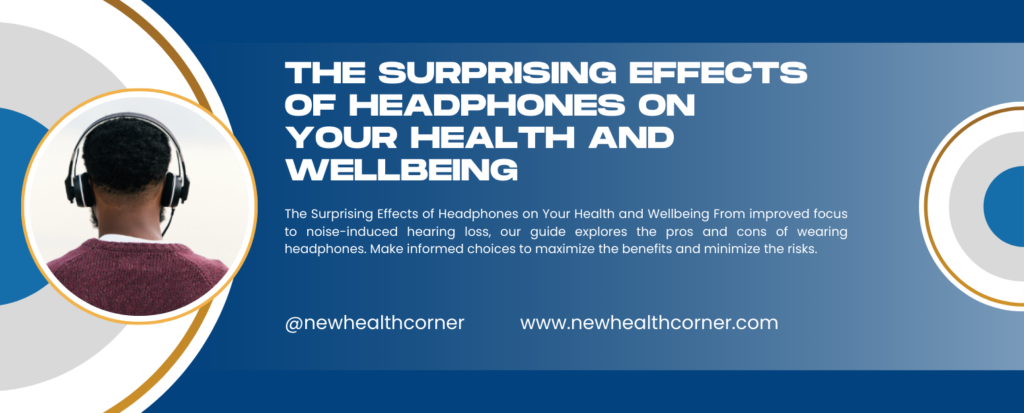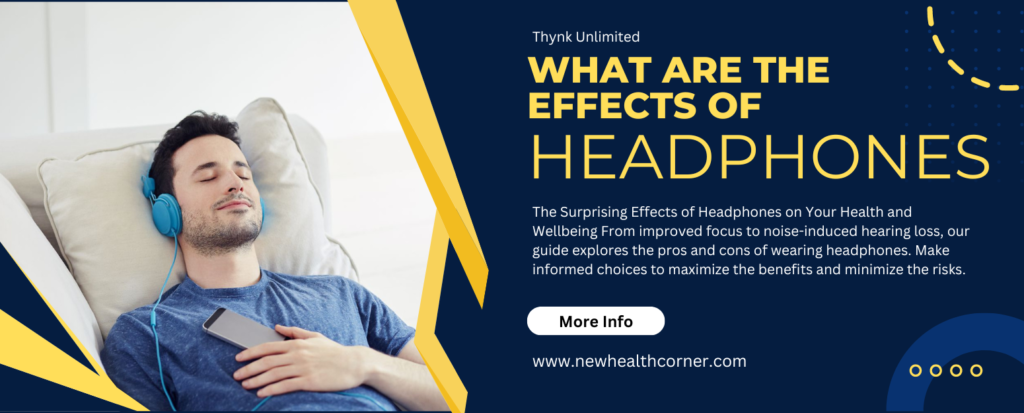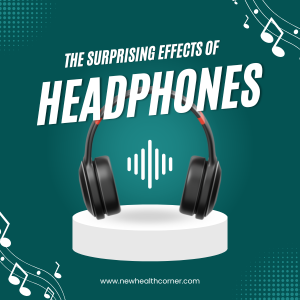what are the effects of headphones?
The Surprising Effects of Headphones on Your Health and Wellbeing From improved focus to noise-induced hearing loss, our guide explores the pros and cons of wearing headphones. Make informed choices to maximize the benefits and minimize the risks.
The Rise of Headphones in Our Daily Lives

The Surprising Effects of Headphones on Your Health and Wellbeing From improved focus to noise-induced hearing loss, our guide explores the pros and cons of wearing headphones. Make informed choices to maximize the benefits and minimize the risks.
In recent years, headphones have evolved from audio accessories to integral parts of our daily lives. Several factors, including technological advancements, changes in work and leisure habits, and the increasing demand for personal audio experiences drive this shift.
Technological Advancements
Since their invention, headphones have advanced significantly. Early models were bulky and offered limited sound quality, but today’s headphones boast advanced features like noise cancellation, wireless connectivity, and high-definition sound. The introduction of Bluetooth technology has been a game-changer, allowing for greater mobility and convenience. Noise-canceling headphones, in particular, have become essential for those who work in noisy environments or travel frequently, providing a quiet space to focus or relax.
Changing Work and Leisure Habits
The rise of remote work and online learning has significantly increased the use of headphones. With many people working from home or in shared spaces, headphones provide a way to create a personal workspace, even in a crowded room. They are also essential tools for virtual meetings, enabling clear communication without the distractions of background noise. Beyond work, headphones have become a staple in our leisure activities. Whether it’s streaming music, watching movies, or playing video games, headphones enhance the experience by delivering immersive sound.
The Demand for Personal Audio Experiences
In our increasingly connected world, the demand for personalized audio experiences has grown. Headphones allow individuals to curate their sound environment, whether they’re listening to a podcast on their commute, meditating with calming music, or enjoying a workout playlist. The portability and privacy offered by headphones make them ideal for on-the-go lifestyles, where people can listen to what they want, when they want, without disturbing others.
A Cultural Shift
Headphones have also become a cultural symbol, reflecting personal style and identity. From sleek, minimalist designs to bold, colorful options, the variety of headphones available allows users to express themselves while enjoying their favorite audio content. This cultural shift has made headphones more than just a tool—they are a fashion statement and a status symbol.
Conclusion
The rise of headphones in our daily lives is a testament to how technology can enhance our experiences, both in work and leisure. As they continue to evolve, headphones will likely remain an essential part of our everyday routines, offering not only convenience and functionality but also a way to connect with the outside world as it seems to us.
The Impact of Headphones on Hearing Health
Headphones have become a ubiquitous part of modern life, offering convenience and a personal audio experience. However, the widespread use of headphones has raised concerns about their impact on hearing health. Prolonged and improper use of headphones can lead to several hearing-related issues, some of which may have long-term consequences.
Noise-Induced Hearing Loss
One of the most significant risks associated with headphone use is noise-induced hearing loss (NIHL). This condition occurs when the delicate hair cells in the inner ear are damaged by exposure to loud sounds. Listening to music or other audio at high volumes, especially over extended periods, can cause permanent hearing loss. The World Health Organization (WHO) has warned that exposure to sound levels above 85 decibels for extended periods can be harmful, and many people exceed this threshold when using headphones.
Tinnitus
Tinnitus, a condition characterized by a ringing or buzzing sound in the ears, is another potential consequence of excessive headphone use. This condition can be temporary or permanent, depending on the level and duration of noise exposure. Tinnitus is often a sign of underlying damage to the auditory system and can significantly affect a person’s quality of life, leading to difficulties with concentration, sleep, and even mental health.
Ear Infections
The use of in-ear headphones, also known as earbuds, can increase the risk of ear infections. When earbuds are inserted into the ear canal, they can trap moisture and create a warm environment that promotes the growth of bacteria and fungi. Sharing earbuds with others or using them for extended periods without cleaning can exacerbate this risk, leading to painful and potentially serious ear infections.
Listening Fatigue
Listening fatigue is a less severe but still important issue related to headphone use. Prolonged listening at high volumes can cause a sense of tiredness or discomfort in the ears, which is often accompanied by a temporary reduction in hearing sensitivity. While listening fatigue is usually reversible, it can indicate that the ears are being overworked and that the volume levels should be reduced.
Safe Listening Practices
To mitigate the risks associated with headphone use, it’s important to adopt safe listening practices. Experts recommend following the 60/60 rule: listening at no more than 60% of the maximum volume for no longer than 60 minutes at a time. Taking regular breaks, using noise-canceling headphones to avoid the need for high volumes, and opting for over-ear headphones instead of in-ear models can also help protect hearing health.
Conclusion
While headphones offer many benefits, including convenience and the ability to enjoy personal audio experiences, it’s crucial to be aware of their potential impact on hearing health. By practicing safe listening habits and being mindful of volume levels and duration of use, individuals can continue to enjoy their headphones without compromising their hearing.
How Headphones Affect Your Posture and Neck Pain

The Surprising Effects of Headphones on Your Health and Wellbeing
Headphones are a common accessory for many people, but their impact on posture and neck health is often overlooked. The way we use headphones, especially over long periods, can contribute to poor posture and lead to neck pain, tension, and other musculoskeletal issues. Understanding these effects is essential for maintaining both auditory and physical well-being.
Forward Head Posture
One of the most common issues associated with prolonged headphone use is the development of forward head posture. This occurs when the head is positioned forward relative to the shoulders, which can happen when looking down at a phone or computer screen while wearing headphones. Over time, this posture puts excessive strain on the neck muscles and the spine, leading to discomfort and pain. The added weight of the head in this position can cause muscles to become overworked, resulting in tension and stiffness.
Neck and Shoulder Tension
Headphones, especially heavier models, can also contribute to neck and shoulder tension. The pressure from over-ear headphones on the top of the head and around the ears can cause discomfort if worn for extended periods. This pressure can lead to muscle strain in the neck and shoulders as the body compensates for the added weight and tries to maintain balance. Additionally, the tendency to hunch the shoulders while using headphones can exacerbate muscle tightness and pain.
Misalignment of the Spine
Prolonged use of headphones, particularly when combined with poor posture, can contribute to the misalignment of the cervical spine (the neck region). This misalignment can lead to a range of issues, including headaches, reduced range of motion in the neck, and chronic pain. Over time, these problems can become more severe if the underlying postural habits are not corrected.
Eye Strain and Headaches
In addition to neck pain, improper headphone use can contribute to eye strain and headaches. When using headphones while focusing on a screen, people often lean forward, creating a posture that strains both the eyes and neck. The combination of screen time and poor posture can lead to tension headaches and discomfort around the eyes, further exacerbating neck pain.
Preventing Posture-Related Issues
To prevent posture-related issues from headphone use, it’s important to be mindful of how you wear and use your headphones. Here are some tips:
Maintain Neutral Head Position: Keep your head aligned with your spine, avoiding the tendency to lean forward. Adjust your screen height so that it’s at eye level, reducing the need to tilt your head down.
Use Lightweight Headphones: Choose headphones that are comfortable and lightweight to reduce the strain on your neck and shoulders. If possible, opt for earbuds or lighter models that don’t exert pressure on your head.
Take Regular Breaks: Avoid wearing headphones for extended periods without breaks. Every 30 minutes, take a moment to stretch your neck and shoulders and reposition your head to a neutral posture.
Practice Neck Exercises: Strengthen and stretch your neck muscles with exercises that promote good posture. Regular neck and shoulder stretches can help alleviate tension and improve your overall posture.
Be Aware of Your Posture: Regularly check your posture while using headphones. Keeping your back straight, shoulders relaxed, and head in a neutral position will help prevent strain.
Conclusion
While headphones are a convenient and enjoyable tool, their impact on posture and neck health should not be underestimated. By being mindful of how you use your headphones and taking steps to maintain good posture, you can prevent neck pain and other related issues, ensuring that your headphone use remains both comfortable and healthy.
The Connection Between Headphones and Mental Health
Headphones have become a staple in daily life, providing a personal and immersive audio experience. However, their impact extends beyond just convenience and entertainment; headphones can also influence mental health, both positively and negatively. Understanding this connection is essential for making informed decisions about how and when to use headphones in a way that supports overall well-being.
Positive Impacts on Mental Health
Stress Reduction and Relaxation: Headphones offer an effective way to create a personal space for relaxation and stress relief. Listening to calming music, nature sounds, or guided meditations through headphones can help reduce stress levels and promote relaxation. The ability to tune out external noise and focus on soothing sounds can be particularly beneficial in busy or noisy environments, offering a form of escape and mental reprieve.
Enhanced Focus and Productivity: Many people use headphones to boost concentration and productivity. Listening to music or white noise while working or studying can help drown out distractions, allowing for better focus. This can be particularly helpful in open office environments or other settings where background noise might be disruptive. For some, the right music can also enhance creativity and motivation, contributing to improved mental well-being.
Emotional Expression and Processing: Music has a profound effect on emotions, and headphones allow individuals to engage with music on a personal level. Whether it’s uplifting tunes to improve mood, or melancholic melodies to process feelings of sadness, headphones facilitate an intimate connection with music that can support emotional expression and processing. This can be a powerful tool for managing emotions and maintaining mental balance.
Negative Impacts on Mental Health
Social Isolation: While headphones provide a personal audio experience, they can also contribute to social isolation. Excessive headphone use, particularly in social settings, can lead to a sense of disconnection from others. This can result in missed opportunities for social interaction and communication, potentially leading to feelings of loneliness and depression. For those who rely heavily on headphones to avoid social engagement, this can reinforce social anxiety and hinder the development of healthy relationships.
Overstimulation and Anxiety: Constant exposure to audio stimuli through headphones can lead to overstimulation, especially when listening to loud or fast-paced music. Overstimulation can exacerbate anxiety symptoms and make it difficult to unwind. Additionally, the habit of using headphones as a constant distraction from thoughts or emotions can prevent individuals from fully processing their feelings, leading to increased anxiety over time.
Dependence and Avoidance: Some individuals may develop a dependence on headphones as a coping mechanism to avoid difficult emotions or situations. While this can provide temporary relief, it can also become a way to avoid confronting underlying issues. Over time, this avoidance can contribute to mental health challenges, such as increased anxiety or depression, as the root causes of distress remain unaddressed.
Balancing Headphone Use for Mental Health
To ensure that headphone use supports mental health, it’s important to find a balance that leverages the positive effects while minimizing potential downsides. Here are some tips:
- Set Boundaries: Establish limits on headphone use, especially in social settings, to prevent isolation. Make time for face-to-face interactions and be mindful of when and why you’re using headphones.
- Choose Content Wisely: Opt for audio content that promotes relaxation, focus, or emotional well-being. Be cautious with content that might contribute to overstimulation or anxiety.
- Practice Mindfulness: Use headphones intentionally rather than as a constant background noise. Allow yourself time to be present in your environment without the distraction of headphones.
- Monitor Emotional Responses: Pay attention to how different types of audio affect your mood and mental state. Adjust your listening habits if certain content leads to negative feelings.
Conclusion
Headphones can have a significant impact on mental health, offering both benefits and challenges. By using headphones thoughtfully and being aware of their effects on social interaction, stress levels, and emotional well-being, individuals can enjoy the advantages they provide while mitigating potential negative consequences. Balancing headphone use with mindful practices can help maintain a healthy relationship with this powerful tool.
Conclusion: Take Control of the Effects of Headphones on Your Overall Wellbeing
Headphones have become an integral part of modern life, offering convenience, entertainment, and even therapeutic benefits. However, their impact on your overall wellbeing extends beyond just delivering sound; they can influence your hearing health, posture, neck pain, and mental health. By understanding these effects and taking proactive steps, you can harness the benefits of headphones while minimizing potential downsides.
To maintain healthy hearing, practice safe listening habits by keeping volumes at a reasonable level and taking regular breaks. Be mindful of your posture when using headphones to prevent neck pain and tension. Use headphones to enhance your mental health, whether by reducing stress with calming music or improving focus, but be cautious of overuse, which can lead to social isolation or overstimulation.
Taking control of how you use headphones allows you to enjoy their advantages without compromising your physical or mental health. By making thoughtful choices and being aware of their effects, you can ensure that your headphone use contributes positively to your overall wellbeing.


Comments